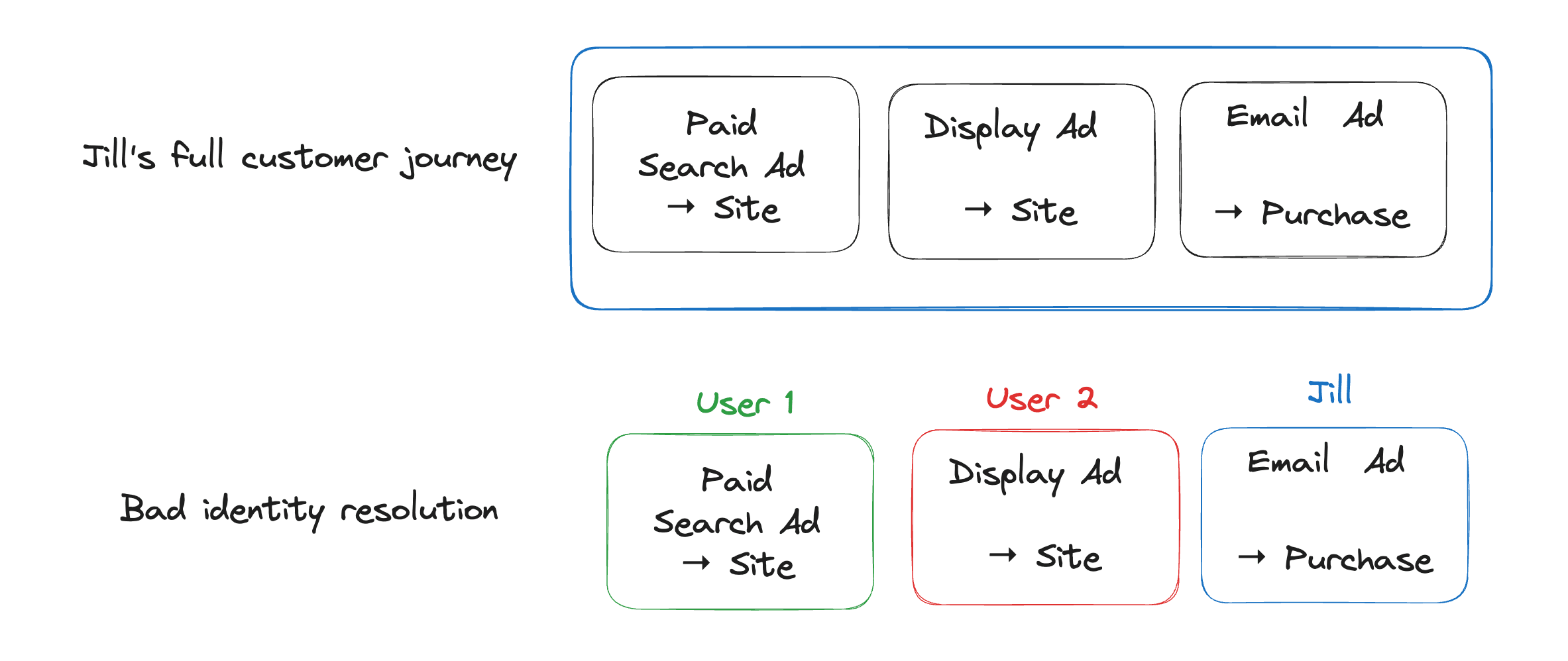Why you should complement digital analytics with better identity resolution
Learn how improved identity resolution can help digital analytics products and customer journeys.
Adam Greco
June 30, 2025
|10 minutes

This week, Hightouch launched Adaptive Identity Resolution. The TL;DR is that Hightouch now offers the industry’s first warehouse-native identity resolution (IDR), which includes the ability to use and toggle between deterministic and probabilistic identity resolution. You can learn all about this by reading the post linked above. In this post, I will discuss how identity resolution impacts digital analytics and how improvements to identity resolution can help improve digital analytics.
Identity resolution underpins digital analytics
While identity resolution is critical to digital analytics, it’s rarely discussed. Organizations purchase a digital analytics product (Google Analytics, Adobe Analytics, Amplitude, Mixpanel, etc.) and assume the vendor will determine if the current visitor is the same as last week or month. After all, how can a digital analytics vendor accurately report the number of unique visitors or show multi-visit user journeys if it cannot stitch together the same user across multiple sessions? But I often find that if you ask people using digital analytics products to explain how their vendor resolves identities, they don’t know. And if you throw out terms like deterministic, probabilistic, and lookback windows, their eyes tend to glaze over!
Here’s how identity resolution in digital analytics platforms works. Most digital analytics products collect both unknown and known user data. Many website and app users are anonymous until they self-identify by authenticating. Typically, the best a digital analytics product can do is wait for a user to authenticate and then use the physical device identifier to stitch together previous digital activity for the current user. Each digital analytics vendor has different “lookback windows” that determine how far back they can review past device IDs to stitch user behavior.
This approach has some shortcomings, however. Every time a user deletes cookies (or a browser does it for them) or switches devices (laptop to phone or vice versa), your digital analytics product may view them as a completely different user. As browsers and cookie blockers obfuscate more user data, organizations are often left with many anonymous identifiers for the same users.
The following outlines some of the ways that deficiencies in identity resolution can negatively impact digital analytics:
Inflated user counts
If your digital analytics product cannot accurately de-duplicate/stitch identities, it will over-inflate unique visitor counts. While I am generally averse to vanity metrics like unique visitors, many organizations want to know how many unique users are reading content, making purchases, filling out lead forms, etc. Unique visitor counts are typically a sum of all unique identifiers, so the worse your identity resolution is, the less accurate (and higher) your unique visitor count will be.
Inaccurate marketing attribution
Marketers need to understand how their various campaigns and channels are contributing to conversions to optimize spend and focus. Attribution generally tracks user touchpoints and assigns value to the touchpoints that lead to a user conversion. Some marketers use first-touch attribution, others use last-touch attribution for campaign analysis. There are even more complex attribution models, including J-curve, U-curve, weighted, linear, etc.
Regardless of the attribution model used for campaign analysis, they all have one thing in common - they rely on accurate identity resolution. To illustrate this, let’s look at an example. Imagine the following digital actions taken by a user named Jill Smith:
- Jill is on her home computer, clicking on a paid search ad for Acme, Inc., and browsing a few products on the website.
- A week later, Jill is on her phone, clicking on an Acme, Inc. display advertisement, and browsing a few products on the website.
- A week later, Jill receives a follow-up email asking if she wants to purchase any of the products she viewed on the website.
- Two weeks later, Jill sees a local Acme, Inc. store, enters, provides her loyalty number, and purchases a $300 product from Acme, Inc.
In this scenario, Jill uses multiple devices over long periods and ultimately purchases a product in a physical store. The correct attribution would include the paid search ad, the display advertisement, and the email message. However, many digital analytics products would treat Jill as multiple users due to device switching, cookie deletion, etc. In addition, many digital analytics products would struggle to include offline purchases in the attribution model. With a linear attribution model, accurate identity resolution would attribute $100 to paid search, $100 to display advertising, and $100 to email.
But, if the digital analytics product didn’t correctly resolve Jill’s identity, it could think the following occurred:
- An anonymous user came from a paid search ad and didn’t purchase anything
- An anonymous user clicked on a display ad, but didn’t purchase anything
- Jill was sent an email and purchased a product a few weeks later.
In this case, the attribution would credit $300 to the email campaign. This attribution might lead Acme, Inc. to reduce its spending on paid search and display advertisements and increase spending on email, which could hurt them in the long run.

The preceding scenario is just one example of how incorrect identity resolution in digital analytics could turn data from an asset to a liability.
Broken customer journeys
As more and more customer interactions move to digital channels, many organizations are focused on understanding and improving customer journeys. After all, if your main interactions are digital, you want to provide the most relevant content, support, and offers at each stage of the customer lifecycle. Unfortunately, many organizations fail at this and provide disjointed customer journeys. For example, you may look at a product on a brand’s mobile app, but when you visit their website, instead of automatically seeing the product of interest, you may have to re-find it. You may also receive an email with a discount for a product you purchased in-store.
While many organizations have invested in customer journey products that allow them to map out specific journey flows, this is useless if identity resolution is inaccurate. Customer journey flow tools need to know if the person who viewed a product on the mobile app is the same person who is now visiting the website. All customer journey flows leverage unique user identifiers to determine if the person has performed the next step in the journey.
Think back to the example of Jill I shared above. An accurate journey map for her would show her engagement across multiple channels. However, with insufficient identity resolution, all her activities would be associated with different assumed users, as one-off interactions rather than part of a holistic journey.
Regardless of how powerful your customer journey technology is, much of the investment made into customer journey technology could be wasted without accurate identity resolution.
Improving identity resolution via the warehouse
In the preceding examples, one of the main reasons digital analytics products struggled to resolve identities correctly is that they are often limited to a subset of customer data. Digital analytics products typically collect data from websites, mobile apps, and digital products. However, digital analytics products don’t often capture a lot of additional customer data. This customer data could include store, financial, customer support, loyalty, etc. Each of these data points offers additional user identifiers that can be used to improve identity resolution. And where does all of this rich customer data reside? The data warehouse (Snowflake, Databricks, BigQuery, etc.).
For many organizations, the data warehouse contains all customer data, including all digital analytics data. Therefore, the data warehouse is uniquely positioned to connect the dots between multiple customer identifiers for each customer. These user identifiers might be anonymous device IDs, loyalty IDs, login IDs, emails, credit card numbers, etc. This customer information is typically not sent to digital analytics products due to how much it would cost and for privacy reasons (e.g, GDPR, CCPA, etc.). However, products like Hightouch can provide the best possible identity resolution once this data resides in the warehouse. Whether deterministically connecting exact matches across data sets or probabilistically using AI-driven “fuzzy matching” to make educated guesses about which user data relates to the same person, the warehouse provides the best odds for accurate identity resolution.
To illustrate this, let’s review an example. Imagine that a user named Bill Stevens performs the following actions:
- Views the ABC, Inc. website anonymously after clicking on a paid search advertisement
- A week later, returns to the ABC, Inc. website and makes a purchase and creates a loyalty account
- A month later, logs a support ticket for an issue he is having related to the product purchased
- A few days later, returns the product to a local store and purchases a different model
In this scenario, some digital analytics products could connect the anonymous visit from paid search to the purchase visit. In a digital analytics world, this is a successful customer journey. But, in addition to having the digital analytics data, the warehouse would also have all customer support and store data. By resolving Bill’s identity in the warehouse, the organization would know that Bill purchased a product due to a paid search advertisement, but that product had an issue and was swapped for another product. The warehouse would merge Bill’s anonymous device ID, loyalty ID, and support ID, and use his returned order number to triangulate back to Bill. This level of identity resolution goes above and beyond what digital analytics typically provide.

Many organizations have realized that they can build more accurate user audiences and journeys by building them upstream in a Composable CDP with access to all customer data and then pushing them to downstream tools. In the preceding scenario, ABC, Inc. could leverage the warehouse to resolve Bill’s identities across all these touchpoints and then apply the resolved ID to all digital analytics data. Products like Hightouch could even send specific support and offline store events (not all of them, but just relevant ones) to the digital analytics product to make its data more complete. People like Bill can be grouped into larger audiences based on all customer behavior and be sent the correct campaigns and journeys.
Another benefit of more accurate, warehouse-based identity resolution is that you can deliver same-session personalization. By leveraging all previously known customer data, products like Hightouch allow you to instantaneously add users to existing audiences based on in-session behavior and identity resolution. Same-session personalization is the pinnacle of marketing and customer journey optimization, since it allows you to capitalize on current and historical customer data to deliver the most personalized experience exactly when customers need it.
Final thoughts
As described above, identity resolution is critical to digital analytics and customer journeys since it underpins both. Without accurate identity resolution, it is impossible to report on marketing campaign performance effectively, assign marketing attribution, or optimize customer journeys. Most digital analytics products contain subsets of customer data, but most customer data resides in data warehouses. The more customer data, specifically user identifiers, you can access, the more likely you are to resolve identities. Hightouch’s warehouse-native identity resolution capability can dramatically improve identity resolution. Once identity resolution has been improved, more accurate user identifiers and audiences can be pushed from the warehouse to digital analytics products to help improve marketing campaigns, attribution, and customer journeys.










